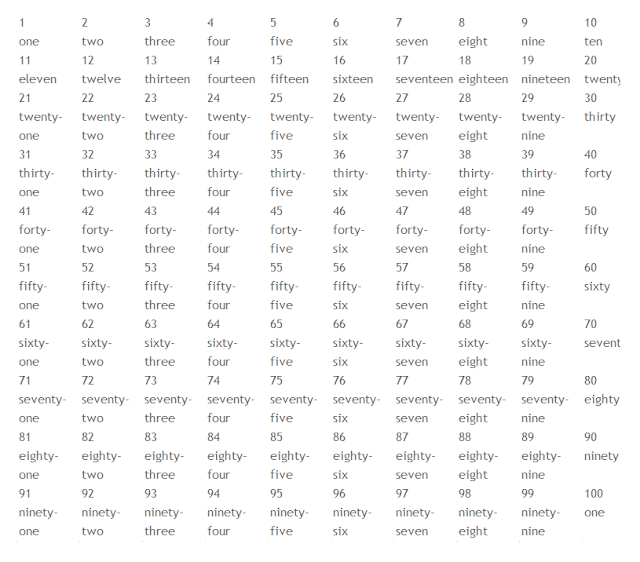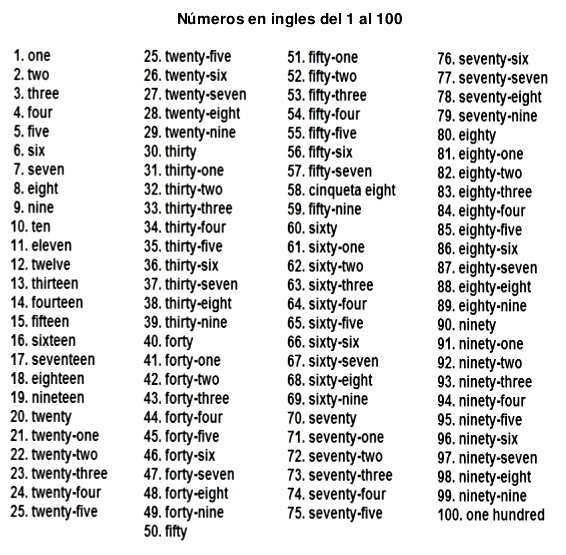Have you ever found yourself struggling to count in English? Whether you’re a language learner or simply looking to brush up on your numerical skills, knowing how to count from 1 to 100 is an essential foundation for communication. Mastering this simple yet powerful skill opens up a world of possibilities, from navigating everyday conversations to exploring complex mathematical concepts. In the following sections, we’ll embark on a journey through the fascinating realm of English numerals, breaking down the patterns and quirks that make this system so unique.

Image: www.tpsearchtool.com
Counting in English is a journey that begins with the foundation of simple numbers, each representing a distinct quantity. Let’s start with the fundamental building blocks of our numerical system:
- 1: One represents the smallest unit, a single entity.
- 2: Two signifies the concept of pairing, two units coming together.
- 3: Three symbolizes the concept of a trinity, three units combined.
- 4: Four represents a group, a collection of four units.
- 5: Five denotes a hand, with its five fingers representing five units.
- 6: Six is a number often associated with completeness or perfection.
- 7: Seven represents luck or good fortune in many cultures.
- 8: Eight is seen as a symbol of abundance or infinity.
- 9: Nine signifying completion or the end of a cycle.
- 10: Ten marking a significant milestone, representing a completion of a set.
These fundamental numbers are the foundations upon which our entire numerical system rests. By mastering these basic building blocks, we can unlock the ability to count to higher numbers, perform simple mathematical calculations, and ultimately engage in a wider range of communication.
Building the Framework: Numbers 11 to 19
From here, we enter the next stage of our numerical journey, where we begin to combine the fundamental numbers we’ve just learned. The numbers from 11 to 19 take on a unique pattern, reflecting a blend of single-digit numbers and the fundamental number “ten.”
- 11: Eleven – the combination of “one” and “ten.”
- 12: Twelve – the combination of “two” and “ten.”
- 13: Thirteen – the combination of “three” and “ten.”
- 14: Fourteen – the combination of “four” and “ten.”
- 15: Fifteen – the combination of “five” and “ten.”
- 16: Sixteen – the combination of “six” and “ten.”
- 17: Seventeen – the combination of “seven” and “ten.”
- 18: Eighteen – the combination of “eight” and “ten.”
- 19: Nineteen – the combination of “nine” and “ten.”
The pattern is clear – the numbers from 11 to 19 follow a consistent structure of “single-digit number + “teen.” It’s like building blocks – combining the foundation of single-digit numbers with the structure of “ten” to create these unique numbers.
The Tens: Unlocking the Decades
Once we conquer the numbers 1 to 19, we encounter a new type of building block: the “tens.” These are the numbers that represent multiples of ten.
- 20: Twenty – two sets of ten.
- 30: Thirty – three sets of ten.
- 40: Forty – four sets of ten.
- 50: Fifty – five sets of ten.
- 60: Sixty – six sets of ten.
- 70: Seventy – seven sets of ten.
- 80: Eighty – eight sets of ten.
- 90: Ninety – nine sets of ten.
- 100: One hundred – ten sets of ten.
These “tens” represent the foundation of our numerical system, providing a framework for understanding larger numbers. They are like stepping stones, leading us towards a greater understanding of the numerical world.
Assembling the Pieces: Numbers 21 to 99
With the foundations established, let’s combine the building blocks we’ve learned to create the numbers from 21 to 99. The pattern is simple: combine a “ten” with any single-digit number.
- 21: Twenty-one: “Twenty” (two sets of ten) and “One”
- 22: Twenty-two: “Twenty” and “Two”
- 23: Twenty-three: “Twenty” and “Three”
- 24: Twenty-four: “Twenty” and “Four”
- 25: Twenty-five: “Twenty” and “Five”
This pattern continues, using the “tens” we already learned (thirty, forty, fifty, etc.) and combining them with all the single-digit numbers (one through nine).
The numbers from 21 to 99 represent the core of our numerical structure, building upon the foundation of the “tens” and single-digit numbers. They allow us to express a wide range of quantities, giving us the power to communicate numbers with clarity and accuracy.

Image: aprendoeningles.com
Mastering the System: The Importance of Practice
Learning to count in English is a journey of discovery, combining logical patterns and a few quirks. The best way to solidify your knowledge is through practice.
- Start with the foundational numbers (1-10) and spend time reciting them repeatedly.
- Gradually introduce the numbers 11-19. Repeating these numbers will help you internalize the pattern.
- Memorize the “tens” (twenty, thirty, forty, etc.) and practice saying those alongside the single-digit numbers (one, two, three, etc.)
- Combine the “tens” and single digits to form the numbers from 21 to 99. Repeat these numbers, gradually increasing your speed.
With consistent practice, you’ll find yourself able to count from 1 to 100 confidently and accurately. This ability will empower you in various situations, enhancing your communication skills and helping you navigate a world filled with numbers.
Exploring Beyond 100: A Glimpse into Higher Numbers
Counting to 100 is just the beginning. The English language extends its numerical system to represent numbers of any size. We use combinations of the building blocks we’ve already learned to express larger quantities:
- 101: One hundred and one
- 102: One hundred and two
- 103: One hundred and three
And so on, until we reach:
- 200: Two hundred
- 300: Three hundred
- 400: Four hundred
We can continue this pattern, extending the system to include thousands, millions, billions, and beyond.
Numeros En Ingles Hasta El 100
The Beauty of Numbers: A World of Possibilities
Learning to count in English opens the door to a world of possibilities. From engaging in everyday conversations about time, dates, and numbers to exploring complex mathematical calculations, mastery of the English numerical system allows you to interact with your environment and the world around you in a more meaningful way. As you continue your journey of language learning, remember that counting is not just about reciting numbers – it’s about understanding the power of these symbols and the vast possibilities they unlock.





